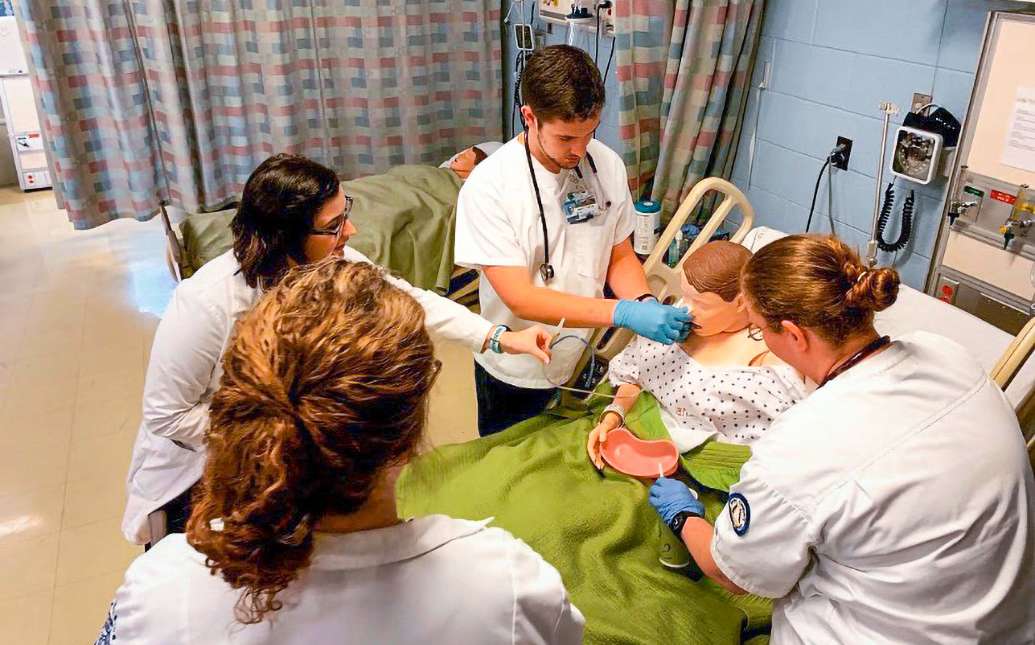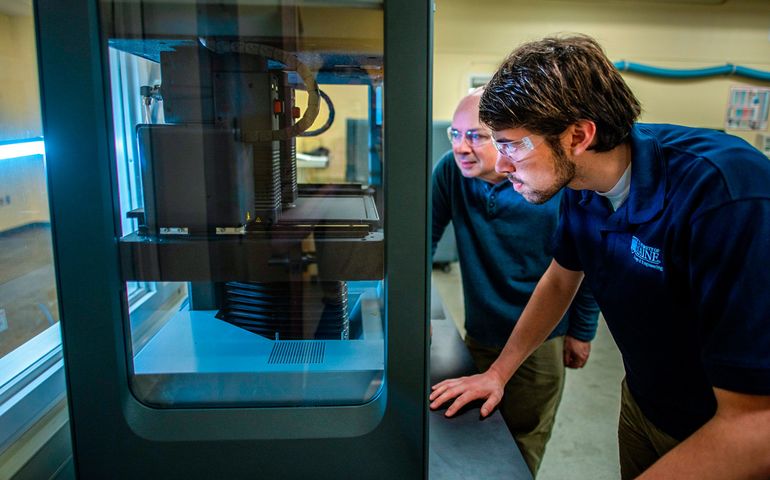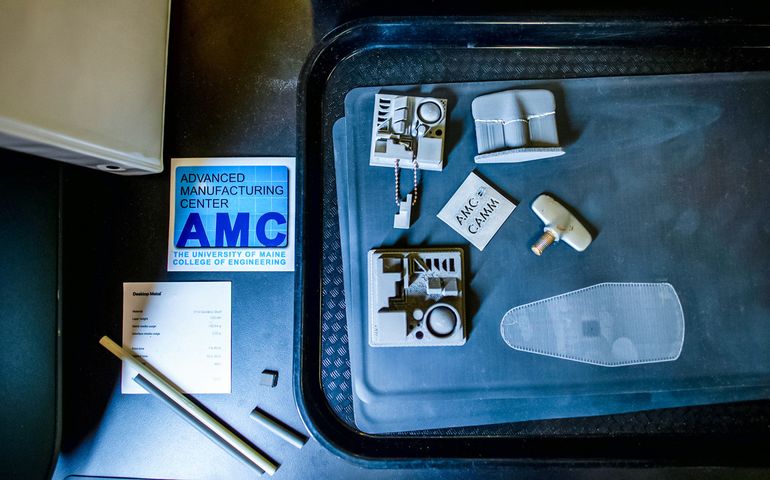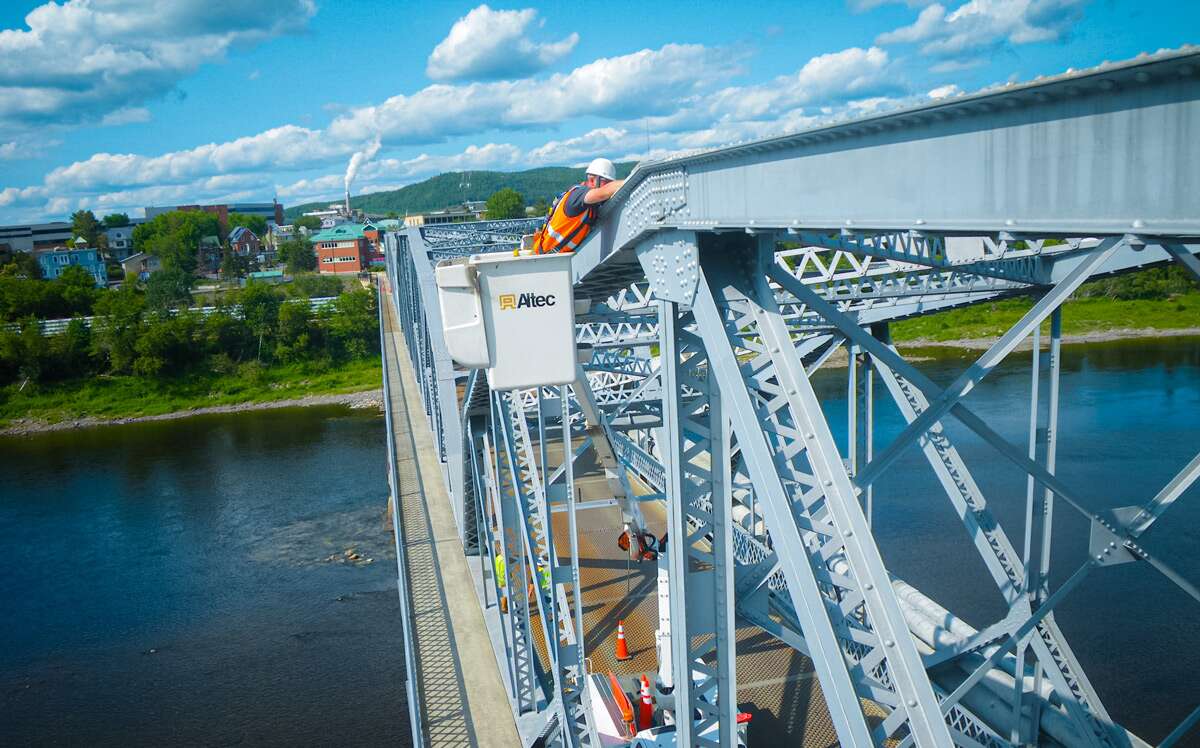
Processing Your Payment
Please do not leave this page until complete. This can take a few moments.
- News
-
Editions
View Digital Editions
Biweekly Issues
- December 1, 2025
- Nov. 17, 2025
- November 03, 2025
- October 20, 2025
- October 6, 2025
- September 22, 2025
- + More
Special Editions
- Lists
- Viewpoints
-
Our Events
Event Info
Award Honorees
- Calendar
- Biz Marketplace
Northern Maine roundup: Manufacturing innovation, nursing education and a $74M bridge replacement
 Photo / Courtesy University of Maine
Alexander Watson, left, a mechanical engineering major at UMaine, researches 3D metal printing at the new Center for Additive Manufacturing of Metals. The center is led by the Advanced Manufacturing Center’s director John Belding, right, and Brett Ellis, assistant professor of electrical engineering technology.
Photo / Courtesy University of Maine
Alexander Watson, left, a mechanical engineering major at UMaine, researches 3D metal printing at the new Center for Additive Manufacturing of Metals. The center is led by the Advanced Manufacturing Center’s director John Belding, right, and Brett Ellis, assistant professor of electrical engineering technology.
 Photo / Courtesy University of Maine
John Belding and Alexander Watson watch the 3D printing of metal objects.
Photo / Courtesy University of Maine
John Belding and Alexander Watson watch the 3D printing of metal objects.
 Photo / Courtesy University of Maine
The Center for Additive Manufacturing of Metals offers services and training to facilitate the adoption of 3D metal printing in businesses around the state.
Photo / Courtesy University of Maine
The Center for Additive Manufacturing of Metals offers services and training to facilitate the adoption of 3D metal printing in businesses around the state.
Putting pedal to the metal in Orono
In Orono, University of Maine undergraduate Alex Watson looks forward to working on his senior team project using new 3D metal printing equipment on campus.
“This is going to be the inaugural year of using this technology, and I’m excited to see how that pans out,” the mechanical engineering major said of his work at the Center for Additive Manufacturing of Metals.
It officially opened in late July with three machines from Desktop Metal, a Burlington, Mass., venture capital-backed startup on MIT Technology Review’s 2017 Smartest Companies list.
Orono’s new 3D metal printing center, one of the first at a U.S. university, isn’t just for academic purposes. It’s also for businesses, including 35 companies that pitched in to fund the $1 million center. It’s housed at the school’s Advanced Manufacturing Center.
Donors included GE Power in Bangor, which contributed $79,600, and Pratt & Whitney in North Berwick, $50,000. Two companies, Hussey Seating Co. in North Berwick and Fiber Materials Inc. in Biddeford, donated $10,000 apiece.
Some of the partner companies have committed to buying a certain dollar amount of trial parts made at the center over a three-year period.
Additional funding came from the Maine Technology Institute, through a cluster initiative program grant of nearly $500,000, with matching funds from UMaine and companies. Some of the funding is considered part of a match for a recent $750,000 federal grant for the Advanced Manufacturing Center.
Besides making parts with reduced lead times and in smaller batches, the metal manufacturing center will work with partner companies to test and conduct research into the process.
Orders already completed include grippers and coating cell masks for GE Power and pieces for a chair assembly system for Hussey Seating it wants to test before spending a lot on an expensive casting tool.
John Belding, director of the Advanced Manufacturing Center, sees great promise for the new system, which fuses smaller metal particles together through 3D printing to form solid metal objects.
“This technology is a keeper,” he said.
Benefits include reduced lead times to make parts, the ability to produce in small, easily customizable lot sizes so companies pay only for the parts they need, and lower costs for setup, materials and labor than other methods.
Belding said the idea for the metal manufacturing center originated about two years ago. “We looked at, ‘How can we move the ball forward to make companies comfortable with the technology and understand it without spending a huge amount of money?’” he said.
Now that the center is up and running, the goal is to get the word out to businesses across the state about using the new technology to speed up development of metal tools, fixtures and complex shapes and parts.
“We take your core concepts and work out the details of how to build it,” says a promotional brochure. “No idea is too big or too small.”
Brett Ellis, assistant professor of electrical engineering technology, is enthusiastic about the research possibilities offered by the center.
“What will separate us from others is the research and education piece,” he said. “The next question is design, and how do you make this stuff work? We all have the expertise and the skill sets to make this happen.”
Bolstering the nursing workforce pipeline
In East Millinocket, as demand for more nurses in Maine continues to rise, educational institutions are responding with added programming to stave off a 3,200 statewide shortfall predicted for 2025.

Starting this semester, students in the associate degree nursing program at Eastern Maine Community College will be spared the trouble of travelling far from home for their coursework or clinical training. They’ll be able to do the former at the Katahdin Higher Education Center in East Millinocket and the latter at Millinocket Regional Hospital and other locations.
“If we can train eight or nine new nurses living in this region, it’s going to help the hospital in the next four or five years,” Deb Rountree, EMCC’s associate academic dean, told Mainebiz. “People are aging out of the profession and looking to retire. That will help eliminate that.”
She said the program expansion should also save employers the trouble — and costs — of having to hire nurses from outside the region or even the state as well as provide job opportunities for people committed to staying in the region.
While nursing students have typically had to travel to Bangor to finish their coursework, they’ll now be able to do all that close to home, Rountree said.
She said that’s important given the large proportion of residents that work a couple of jobs, don’t have adequate child care or reliable transportation, and can’t always go to a campus an hour or more away.
“We’re fortunate the Higher Education Center can provide opportunities like this,” she said. On a more general note, she said EMCC works with employers of all stripes to provide workforce development and training and said the region has a lot to offer companies looking to establish a presence there.
“For a small rural area of the state that has had so many struggles, there are so many rich resources in this community,” she added.
Further north where the University of Maine campuses at Fort Kent and Presque Isle joined forces on an academic partnership last year, they plan to double the number of program slots this fall from 16 to 32.
The program dispatches UMFK faculty to UMPI about 50 miles away so that students unable to travel to Fort Kent can pursue a four-year nursing program in Presque Isle but get their degrees from UMFK. Participants are UMPI students for the first two years and UMFK students for the remaining two.
Over the next decade, the need for nurses is expected to grow substantially as the size of the state’s 65-and-older population jumps by more than a third, just as a wave of nursing professionals in their 50s starts cutting back hours and heads into retirement.
Building a new bridge between Maine and Canada
After nearly a century of wear and tear, the Madawaska-Edmundston International Bridge over the St. John River will be dismantled to make way for a new one. It was built in 1920 to replace a cable ferry.

While the $74 million bridge replacement project is to be advertised in the fourth quarter of 2020, the Maine Department of Transportation says that physical construction may not start until 2021.
The project will be funded in part by a $36 million grant from the U.S. Department of Transportation awarded in late July.
In early August, Maine DOT spokesman Paul Merrill told Mainebiz that officials are still talking with counterparts in Canada about how to split the remaining $38 million.
The 942-foot-long bridge serves as a vital link to Canada for Maine companies including Twin Rivers Paper Co. Officials decided to replace the structure after experts concluded that an upgrade would cost more than building a new one.
In 2017, the bridge was deemed “fracture critical” with numerous deteriorating support beams, decking and substructures. Since then, Maine and New Brunswick officials have limited bridge traffic to vehicles less than 5 tons, which excludes most commercial trucks.
The weight limit and temporary closures of the bridge have forced many residents and businesses to make long detours.
Twin Rivers Paper Co., one of the largest employers in northern Maine, “has had to reroute large trucks through Van Buren, adding up to 75 miles and nearly two hours of travel time round-trip as well as incurring millions of dollars in increased transportation costs,” U.S. Sen. Susan Collins, R-Maine, said in a news release.
“This award represents a significant leap forward in our work to build a new, more-modern link between Madawaska and Edmundston, New Brunswick,” said MaineDOT Commissioner Bruce Van Note in a statement.
On its website, MDOT gives a construction start date estimate of 2021 and lists Maine construction firms Reed & Reed Inc. and Cianbro, along with Caldwell & Ross of Fredericton, New Brunswick, as prequalified contractors that will be allowed to bid on the project.
Mainebiz web partners
Related Content

The Giving Guide
The Giving Guide helps nonprofits have the opportunity to showcase and differentiate their organizations so that businesses better understand how they can contribute to a nonprofit’s mission and work.
Learn More
Work for ME
Work for ME is a workforce development tool to help Maine’s employers target Maine’s emerging workforce. Work for ME highlights each industry, its impact on Maine’s economy, the jobs available to entry-level workers, the training and education needed to get a career started.
Learn More
Groundbreaking Maine
Whether you’re a developer, financer, architect, or industry enthusiast, Groundbreaking Maine is crafted to be your go-to source for valuable insights in Maine’s real estate and construction community.
Learn more-
The Giving Guide
The Giving Guide helps nonprofits have the opportunity to showcase and differentiate their organizations so that businesses better understand how they can contribute to a nonprofit’s mission and work.
-
Work for ME
Work for ME is a workforce development tool to help Maine’s employers target Maine’s emerging workforce. Work for ME highlights each industry, its impact on Maine’s economy, the jobs available to entry-level workers, the training and education needed to get a career started.
-
Groundbreaking Maine
Whether you’re a developer, financer, architect, or industry enthusiast, Groundbreaking Maine is crafted to be your go-to source for valuable insights in Maine’s real estate and construction community.
ABOUT
NEW ENGLAND BUSINESS MEDIA SITES
No articles left
Get access now
In order to use this feature, we need some information from you. You can also login or register for a free account.
By clicking submit you are agreeing to our cookie usage and Privacy Policy
Already have an account? Login
Already have an account? Login
Want to create an account? Register
Get access now
In order to use this feature, we need some information from you. You can also login or register for a free account.
By clicking submit you are agreeing to our cookie usage and Privacy Policy
Already have an account? Login
Already have an account? Login
Want to create an account? Register









0 Comments